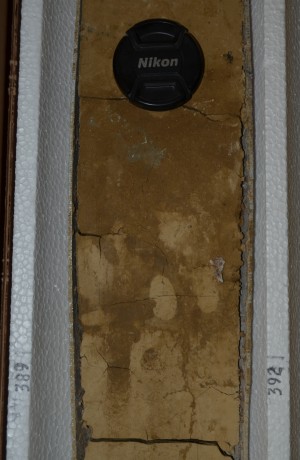Adhesive Meniscate Burrows
(Naktodemasis)
 Vertical to inclined to horizontal, elliptical burrow chambers with mud-lined walls, and menisci filling the chambers. The burrows may be made of isolated chambers (see the core example on the right), but the chambers more often are arranged one after another to make linear, wandering traces up to several inches long. Because the burrow fill adheres to the surrounding matrix such that the burrows are found only in cross-section and not as casts or molds, they are described as "adhesive".
Vertical to inclined to horizontal, elliptical burrow chambers with mud-lined walls, and menisci filling the chambers. The burrows may be made of isolated chambers (see the core example on the right), but the chambers more often are arranged one after another to make linear, wandering traces up to several inches long. Because the burrow fill adheres to the surrounding matrix such that the burrows are found only in cross-section and not as casts or molds, they are described as "adhesive".
This trace has the "official" scientific (ichnogenera) name of Naktodemasis, and it is typically found in non-marine rocks, particularly paleosoils. Sometimes it is associated with rhizoliths (tree roots), which leads some to interpret as being made by beetles and/or insect larvae that tunneled through wet soil in search of roots to eat. The example on the right is from a core in the Pleistocene Tulare Formation that shows these burrows at an interface between a soil layer developed over lacustrine mudstones in the EXF 376T well at Midway-Sunset oil field. Below are more core photos from the same well, in addition to several photos of simulation models made by Smith and Hasiotis (2008) in which they made burrows by getting Cicada larvae to tunnel through layers of colored sand. Although this trace is most often observed in the San Joaquin Valley in cores of the Tulare Formation, there is no reason why it would not be found in non-marine facies of the Big Blue and Temblor Formations as well.
References:
|